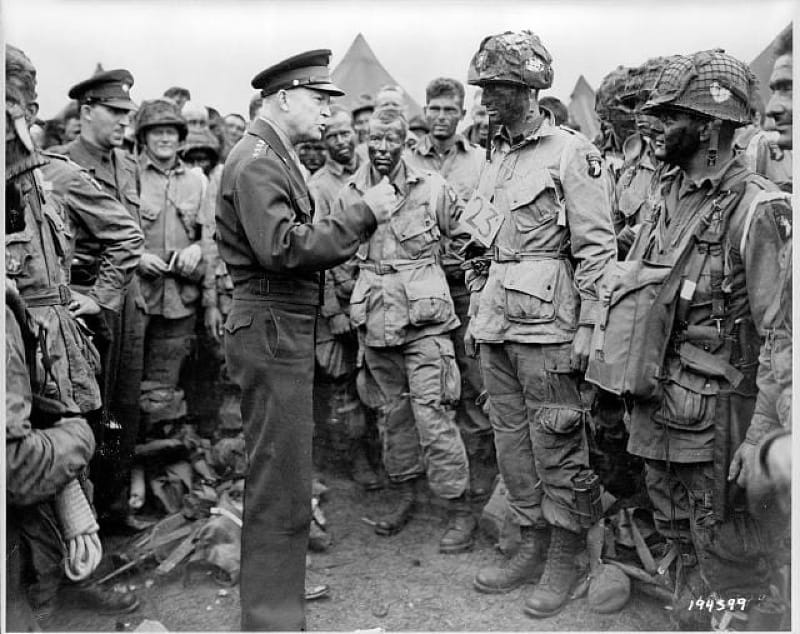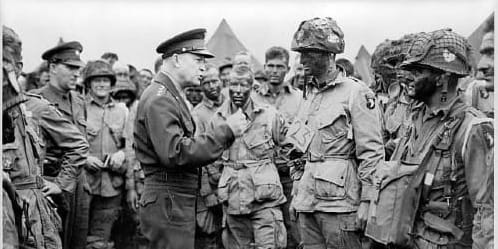The Power of a Leader’s Empathy: Lessons from General Eisenhower

Empathy is often touted as a critical leadership quality, and its significance is increasingly needed in our offices. On this anniversary of D-Day, let's look at the historical example of General Dwight D. Eisenhower’s leadership during World War II. Specifically, we’ll explore how his decision to walk amongst and speak to the troops before their perilous D-Day mission exemplifies the power of empathy in leadership and how these lessons apply to today’s young professionals.
The Context of D-Day: Eisenhower’s Empathetic Leadership
On June 6, 1944, known as D-Day, Allied forces launched a massive invasion on the beaches of Normandy, France. This operation marked a turning point in World War II. General Eisenhower, the Supreme Commander of the Allied Expeditionary Force, faced the enormous responsibility of sending thousands of young men into battle, many of whom would not return. Understanding the gravity of the situation, Eisenhower chose to spend time with the paratroopers of the 101st Airborne Division before their mission.
Eisenhower’s Walk Among the Troops
On the eve of the invasion, Eisenhower visited the troops in England. He didn’t deliver a grand speech or issue formal orders. Instead, he walked among the soldiers, engaging in casual conversations, listening to their concerns, and offering words of encouragement. In the picture above, probably one of the most famous of D-Day, Eisenhower is captioned as saying "Full victory--nothing else." This is not entirely accurate. In the photograph, Eisenhower is instructing about fly fishing and how the right flick of the wrist can get the fly to lay out perfectly on the water. He knew his men did not need to think more about their mission. He was trying to give them a taste of humanity and home and get their mind off the fearful task ahead before they entered combat. This act of empathy—showing genuine concern for their well-being and understanding the fears they harbored—had a profound impact on the troops' morale.
The Impact of Eisenhower’s Empathy
Eisenhower’s empathetic approach fostered a sense of trust and camaraderie. Soldiers felt valued and understood, knowing their leader was not just commanding from afar but was personally invested in their lives and futures and relatable. This emotional connection bolstered their courage and determination, crucial elements for the success of such a risky operation.
Empathy in Modern Leadership
Eisenhower’s actions provide timeless lessons on the power of empathy in leadership. In today’s workplace, empathy is just as essential for fostering a positive and productive environment. Here’s why empathy matters and how young professionals can integrate it into their leadership styles.
Building Trust and Loyalty
Empathy helps build trust and loyalty between leaders and their teams. When employees feel understood and valued, they are more likely to be engaged and committed to their work. This trust is the foundation for effective teamwork and long-term success.
Example: Consider a manager who takes the time to understand their team members’ individual strengths, challenges, and career aspirations. By showing genuine interest in their personal and professional growth, the manager builds a loyal and motivated team.
Enhancing Communication
Effective communication is vital in any organization, and empathy plays a key role in facilitating open and honest dialogue. Empathetic leaders listen actively and respond thoughtfully, creating an environment where employees feel comfortable sharing their ideas and concerns.
Example: In team meetings, an empathetic leader encourages input from all members, listens without interrupting, and acknowledges different perspectives. This inclusive approach leads to better decision-making and innovation.
Resolving Conflicts
Conflicts are inevitable in any workplace, but empathetic leaders are better equipped to handle them constructively. By understanding the underlying emotions and viewpoints of those involved, empathetic leaders can mediate disputes and find mutually beneficial solutions.
Example: When a disagreement arises between team members, an empathetic leader seeks to understand both sides, addresses the root causes of the conflict, and facilitates a resolution that respects everyone’s needs and feelings.
Fostering Inclusivity
Empathy promotes inclusivity by valuing diverse perspectives and experiences. Leaders who prioritize empathy are more likely to create a culture where everyone feels respected and included, leading to higher employee satisfaction and retention.
Example: An empathetic leader actively seeks to understand the unique challenges faced by employees from different backgrounds and implements policies that support diversity and inclusion, such as flexible working arrangements or mentorship programs.
Supporting Mental Health
The modern workplace can be stressful, and empathetic leaders play a crucial role in supporting their team’s mental health. By recognizing signs of burnout and offering support, leaders can help employees maintain a healthy work-life balance.
Example: A leader notices an employee is consistently working late and appears stressed. Instead of ignoring the situation, the leader checks in with the employee, offers support, and discusses ways to manage their workload more effectively.
Applying Eisenhower’s Lessons Today
To integrate empathy into your leadership style, consider these actionable steps inspired by General Eisenhower:
- Be Present and Approachable: Like Eisenhower walking among his troops, make an effort to be visible and approachable to your team. Regularly check in with employees, both formally and informally, to show that you care about their well-being.
- Listen Actively: Practice active listening by giving your full attention to the speaker, asking clarifying questions, and reflecting on what they’ve said. This shows that you value their input and are genuinely interested in their perspective.
- Show Genuine Concern: Demonstrate that you care about your team members as individuals, not just employees. Celebrate their successes, offer support during difficult times, and show empathy in everyday interactions.
- Foster Open Communication: Create a safe space for open and honest communication by encouraging feedback, being transparent about decisions, and addressing issues promptly and empathetically.
- Lead by Example: Model empathetic behavior in your interactions. Your actions set the tone for the rest of the team, so embody the empathy you wish to see in others.
Conclusion
General Eisenhower’s empathetic leadership during D-Day offers powerful lessons for modern leaders. By walking among the troops and connecting with them on a personal level, he demonstrated the profound impact of empathy on morale and success. Today’s young professionals can draw inspiration from Eisenhower’s example to cultivate empathy in their own leadership styles, creating workplaces where trust, communication, inclusivity, and mental well-being thrive. In doing so, they will not only enhance their team’s performance but also foster a positive and supportive work environment that benefits everyone.
Empathy is not just a nice-to-have trait; it is a cornerstone of effective leadership. By embracing empathy, you can inspire and empower your team to achieve great things, just as Eisenhower did on that fateful day in 1944.
If you are enjoying the Gryphon, subscribe to keep receiving the insights you need to be a better leader!

Member discussion